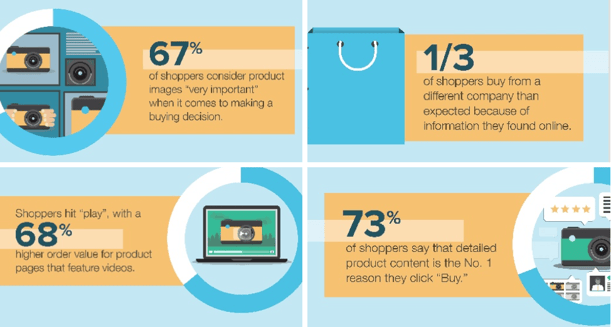
Your product detail page is the backbone of your ecommerce strategy. It's often the first thing a shopper finds when searching for their product needs from a retailer's site or search engine. And it is the place from which a shopper ultimately decides whether or not to click "buy." Get the product detail page wrong, and all of your other marketing efforts matter little.
How to Optimize Any Product Detail Pages
By paying special attention to crucial product detail pages, you can grow your revenue and business. Here are seven tips to optimize your product detail page.
1. Tell Your Brand Story Through the Details of Your Product Page
Good product pages let potential customers know about the product's features and benefits. Great product pages go beyond that rational approach. They tell your brand story, making a connection with your audience through every detail.
Emotions influence every bit of our decision making process. A storytelling approach helps you engage your audience in a way that rational arguments cannot. Use a narrative approach, showing your product and its core benefits in a context that your potential customers can easily relate to.
2. Align Your Product Name with Search Volume and Trends
Search engine optimization should be a core part of your product page considerations. In fact, a Google search is now the single biggest reason most visitors land on your e-commerce website. Optimizing your product detail page begins early in the process: with the naming of the product itself.
Ideally, each product name should align with search engine trends as they relate to your audience. If "men's pajamas" gets more search volume than "men's sleepwear," consider renaming your products accordingly to account for that trend. The more closely your product name is aligned with your larger SEO strategy, the better.
3. Add Robust, Keyword-Focused Product Descriptions
Of course, SEO goes far beyond strategically aligning your product name. In fact, the entire content on your product page should be optimized for keywords that are relevant to your product and audience alike.
That doesn't mean keyword stuffing. It does, however, mean naturally integrating relevant keywords into your product descriptions. Ideally, those keywords should match the overall theme of your product name for better SEO alignment.
4. Build Thorough and Accurate Descriptive Content
Speaking of product descriptions: your product detail page lives and dies with the quality of its content. The better you can describe your offer and its benefits, the more likely your audience will be to convert. Consider every piece of the page an opportunity to better tell your product and brand story.
While storytelling is important, accuracy is absolutely crucial. Grammar and sentence structure mistakes are obvious fixes, but you should also stay away from false advertising or exaggerated claims. Use your product page to highlight essential benefits, not to mislead your audience.
5. Feature Compelling Visuals to Increase Consumer-Product Connection
Don't think of content as simply text on a page. Visuals play a core part in getting your message across while getting and keeping your audience's attention. With the rise of mobile and shortening attention spans, images and videos can have a significant impact on your conversion rates.
Visuals allow you to bridge the gap of the digital shelf, allowing your audience to 'touch and feel' your product even as they look at it online. Feature not just regular product shots, but alternative views as well as examples of your product in action.
6. Leverage Social Proof to Increase Credibility
Brand equity across industries is declining, as audiences are losing faith in the sometimes bombastic claims many companies make about their products. That, in turn, has led to the rise of a crucial communication tactic: social proof.
Through testimonials and user reviews, you can lend credibility to your claims and statements. Expert reviews add another layer of trust for potential buyers. Strategically featuring social proof on your product detail pages can lead to drastic raises in conversion rate and shopping cart adds.
7. Maximize Conversion Point Opportunities
Finally, don't forget about the final step and ultimate goal of your product page: the conversion. All of the above matters little if your visitors find that actually buying your product is complicated or confusion. In other words, you have to maximize your conversion point opportunities.
That means making the call to action buttons stand out, and placing them next to your most compelling content on the page. Additional features, such as the one-click buy button that has become increasingly popular for major e-commerce merchants, can also make a difference in driving your audience from your product page to become a customer.
Maximum Product Page Optimization Requires Attention to Detail
Every product is unique, which means that every product page should be unique. From your brand story to the technical optimizations necessary to achieve maximum SEO, the above tips can help you build a powerful page that maximizes your ecommerce conversions.
Written by: Cara Wood
Cara Wood (she/her) is a writer and former director of brand journalism at Salsify, where she specialized in creating content to help brands excel in ecommerce. Her work has helped organizations enhance their digital shelf and product experience management strategies.
Recent Posts
How Retailers Can Use Geolocation To Create Personalized Shopping Experiences
3 Examples of a Personalized Shopping Experience and How To Create Them
Why Companies Rebrand and How To Successfully Pivot
Subscribe to the Below the Fold Newsletter
Standing out on the digital shelf starts with access to the latest industry content. Subscribe to Below the Fold, our monthly content newsletter, and join other commerce leaders.



.svg)